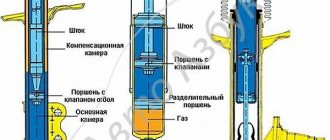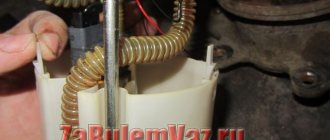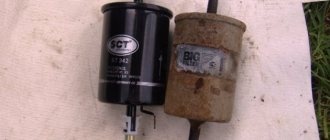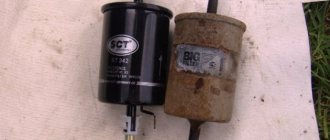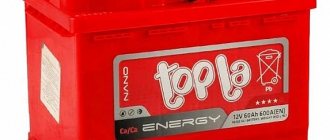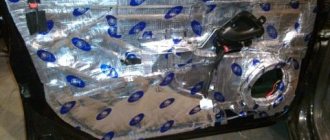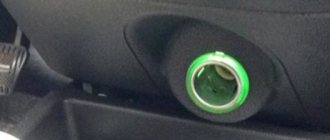Potential buyers and car owners are concerned with the question: does the Grant model have a galvanized body or not? The concern is easy to understand: the cost of the body is a significant part of the price of the budget car Lada Granta, galvanization protects the structure from the influence of adverse external factors.
Different sources provide conflicting information. Official representatives of the AvtoVAZ concern claim: the Lada Grant has a galvanized body, some sales dealers refute the statement.
How to care for an expensive car body, regardless of whether the body of the Lada Grant is galvanized or not?
Information from official representatives of AvtoVAZ
At the concern's factories, metal body elements are treated with a layer of galvanization. The low cost of the car does not allow covering the entire metal area; they protect the most vulnerable areas susceptible to corrosion:
• doors; • hind wings; • rear wheel niches; • luggage compartment lids; • body protective screen; • floor; • protective casing; • frame details; • rear wing groove.
The main vital structural elements are treated with a coating; the question can be removed whether the body of the Lada Grant is galvanized or not.
Galvanization: has the body been processed at the proper level?
ATTENTION! A completely simple way to reduce fuel consumption has been found! Don't believe me? An auto mechanic with 15 years of experience also didn’t believe it until he tried it. And now he saves 35,000 rubles a year on gasoline! Read more"
Today, at the Togliatti plant, the processing of the body and its metal parts involves a standard layer of galvanization. True, not the entire area of the car is subjected to this process, but only the most vulnerable areas of the body, such as the bottom, etc. First of all, these areas are located close to the road surface, thereby being damaged quite often: chips, scratches and damage to the integrity of the surface paintwork Such places of the body are a common phenomenon.
Note. What does the galvanizing layer do in this case? It effectively protects the body frame from rusting, preventing the process from further progressing rapidly in areas of chips and scratches.
Lada Granta galvanized body
On the one hand, a layer of galvanization, of course, cannot completely protect the metal from corrosion. On the other hand, if it were not there, the elements would begin to rust in short periods of time, after some minor accident or the car falling off the jack.
Galvanizing the Lada Granta body
There is a lot of controversy regarding galvanizing. In particular, the question concerns the following: is the body of the Lada Granta sufficiently galvanized, if we keep in mind the percentage ratio. Here is what I would like to say about this:
- Lada Granta is considered a budget car, which automatically excludes full processing;
- It is precisely because the Granta is a budget car that it has fewer body elements designed to work in harsh conditions.
On the other hand, all “vitally” important body elements of the car are, of course, coated at the factory with a layer of galvanization. This happens in the press shop, where zinc is applied to the steel sheet on both sides.
Is it worth carrying out additional anti-corrosion treatment on the Lada Granta? Car owners often ask on forums. The manufacturer does not advise doing this, hinting that he has foreseen everything himself. On the other hand, no matter what guarantee against corrosion AvtoVAZ gives for the first 6 years of car operation, we were not born yesterday, and we understand that the manufacturer’s guarantee is one thing, but the real situation is completely different.
Here are the areas of the domestic car that are most at risk:
- Rear wheel wells and fenders;
- Trunk sides;
- Bottom;
- Door pillars and trim;
- Protective components, etc.
Some car owners claim that some Grants do not have galvanization at all, which explains the low cost of the car. Is it really? AvtoVAZ categorically denies this information, claiming the opposite. Yes, galvanizing does not occur in full, but the strategy of protecting the most important areas of the body is carried out without fail.
In general, quite a lot of myths about domestic car models have been appearing lately. Some people, supposedly cool specialists, come to various topics and start spouting all sorts of nonsense that AvtoVAZ products will soon crumble before our eyes. It is noteworthy that most of the “false experts” are personally unfamiliar with modern versions, but judge products based on old models from the 90s.
The modern corrosion resistance of VAZ models, even the most budget ones, has improved significantly. Modern paint booths, “smart” robots, universal stamping shops with the appropriate equipment - all this is available and working at AvtoVAZ today. And the result does not take long to wait: body gaps have decreased, parts have been fitted perfectly. In addition, all surfaces of the body undergo appropriate treatment, since the entire body is immersed in a bath of primer. If earlier it was difficult to imagine, today no one doubts the power of a robot that can easily lift a heavy body as a whole and dip it properly into the composition.
What is the Lada Granta body made of?
It is also worth noting that today any car produced by AvtoVAZ undergoes rigorous testing. For example, it is kept in a saline solution for more than 2 days, then scratched to the metal. So what: corrosion only shows up slightly, but the Niva’s body, painted using old technologies and not galvanized, also subject to a similar test, is literally eaten away by rust.
The issue with body rigidity has also been successfully resolved today. The same Lada Granta, despite its budget, is equipped with a reinforcing “bulkhead” in the rear. This applies to the sedan, but the liftback, which will be described in detail below, has been worked out even more carefully in terms of body rigidity. The fact is that 5-door modifications do not provide rear reinforcement, which is why maximum rigidity is given in this case. Compared to the “chisel”, the body rigidity of the Lada Granta (hatchback) is increased by 2 times!
Lada Granta body number
By the way, for those who are interested, the body number of the Lada Grant can be found in the engine compartment right on the edge near the shock absorber strut on the front passenger side.
Factory galvanizing methods
Discussions about domestically produced cars do not subside. They argue about the Lada Granta, whether the body is galvanized, how the price corresponds to the quality, meanwhile the giant AvtoVAZ continues its strategy of improving the cars it produces and improving galvanization as well.
The factories use the following coating methods:
• thermal galvanizing is the most reliable;
• galvanization, when zinc is deposited from a solution on the surface of parts under the influence of electric current;
• coating with a primer with preliminary application of manganese, zinc and iron salts to the metal surface.
Debunking myths
1. Does a galvanized body not rust?
Even if, when buying a car, when asked whether Granta is galvanized or not, the dealer gives you a positive answer, it’s too early to calm down. Due to the very thin coating layer and its partial nature, rapid reduction of the galvanizing layer is guaranteed.
Without additional treatment, the body will still rust.
2. Does a new car require additional body work?
Factory protection is imperfect. Even a new car requires preventive anti-corrosion treatment. During operation, the body coating is subjected to strong mechanical stress, causing cracking of the coating, moisture entering the cavities and corrosion of body elements.
3. Does the aluminum body not rust?
In fact, the entire body cannot be made of stainless aluminum; steel is also used, it is susceptible to corrosion. Aluminum oxidizes over time and turns into powder.
4. Will the factory rust protection last for many years?
The rate of metal corrosion largely depends on operating conditions and climatic conditions. A metal layer 0.6 mm thick can rust through in six years! The body needs to be treated.
5. Mud flaps and fender liners, plastic covers are useless?
Not true. The equipment reduces the abrasive effect of dirt and sand on the body.
Installation of elements is carried out using self-tapping screws, external joints are treated with anti-corrosion coatings. Mud flaps are attached with maximum adherence to the wings and body.
Regardless of whether the Granta body is galvanized or not, preventive treatment of the body must be performed.
Is Lada Vesta's paintwork reliable?
The quality of the paintwork is also at the highest level. Amateurs and automobile experts checked whether the Lada Vesta's paintwork was reliable. No imperfections, scuffs or various coating defects, which often happened on previous models, were noticed.
Although the small thickness of the Lada Vesta LPC may raise doubts. But this trend is characteristic of many modern cars - environmental standards impose restrictions on the depth of the paint and varnish layer. High-quality soil protects the iron well, and corrosion is unlikely to spread due to ordinary chips.
The bottom, sills and arches have been additionally treated with a layer of anti-gravel. In total, the thickness of the body metal is about 0.7 mm.
On a note!
If a Lada Vesta with a galvanized body rusts during the warranty period, do not hesitate to contact the dealer. You have the right to demand reimbursement of the cost of repair or elimination of this problem.
Car anti-corrosion treatment
The most favorable period for carrying out work is in dry, warm weather. Frequency: once every one or two years.
At home, bitumen-based anti-noise mastics are used for anti-corrosion treatment of external unprotected parts of metal. They can be drying or non-drying; the latter retain high elasticity, but do not have high mechanical strength. The mastics are applied in a thick layer up to 0.4 mm. Thanks to this, a good sound insulation effect is obtained.
To treat hidden body cavities, either oil-based preparations are used, which can fill them during the formation of microcracks, or elastic, paraffin- or wax-based preparations that are good at displacing moisture.
Careful car care will help increase its service life in any case, regardless of whether your Lada Granta has a galvanized body or not.
Painting Lada Vesta
It begins immediately after the completion of the cataphoretic priming process. First, the preparatory equipment is dismantled from the car, which is placed in a special container behind the car, and the paint shop is installed. This equipment allows you to open and close the doors, hood and trunk. By the way, the entire line is equipped with special emergency buttons, pressing which completely stops the conveyor.
The painting stage begins with the application of joint mastic to all joints, which increases corrosion resistance. In addition, line workers also spray anti-noise mastic, which reduces the noise level in the cabin.
After this comes the turn of applying primer. In this case, the bulk of the operation is performed by robots, but workers also have to prime the metal in places where the robots cannot reach. For the most part, these are the inner sides of the pillars, the edges of the roof, covered by doors, etc.
d. The color range of the primer is limited to only two tones - light and dark. His choice depends on the future color of the Lada Vesta.
First, a primer is applied to the body. After priming is completed, the machines are sent via conveyor to the secondary soil processing area. In this department, employees eliminate painting defects using special paste and brushes.
Only after completing all these stages, which take about 3 hours, the finished body is sent to the painting booths, where robots work side by side with people. First, the metal is covered with a layer of paint, after which comes the turn of varnishing. At the end, the painted sedan body enters a thermal chamber, where it is dried. This takes about 40 minutes.
At the end, the finished body is sent to polishing and the assembly line.
After drying, a few final touches remain - polishing and anti-corrosion treatment of cavities. In the latter case, plant workers, armed with special sprayers with long nozzles, fill the internal surfaces of the cavities (thresholds, pillars, etc.) with an anti-corrosion compound.


